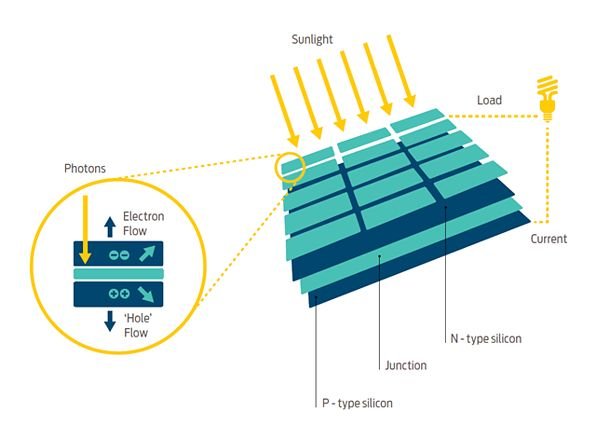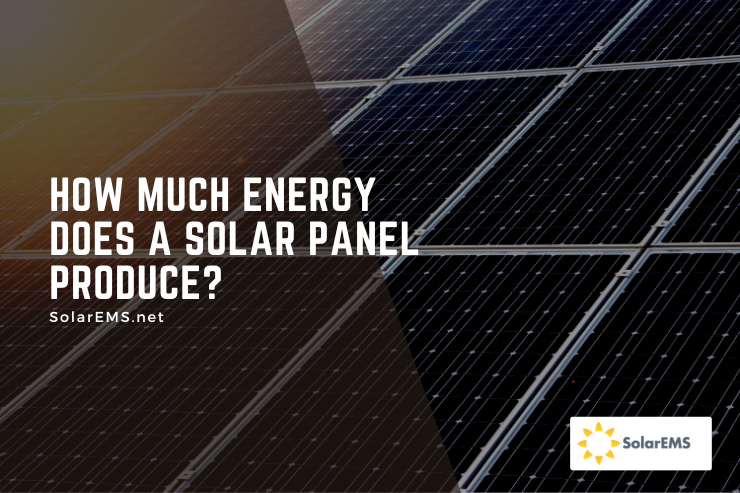The world is running behind sustainability and installing solar panels is one such way you can contribute to sustainability.
So, are you planning to install solar panels? The very first thing that comes to everyone’s mind while thinking about installing solar panels is, how much energy they produce.
Right? You must have this question in your head too. So, c’mon, let’s get the answers to all your questions. Or you can jump to using the calculator here.
What Is A Solar Panel?
Solar panels are devices that are used to convert the rays of the sun (light energy) into electricity.
In other words, a solar panel is a collection of solar cells ( also known as photovoltaic cells) used to produce electricity via the photovoltaic effect.
How Does a Solar Panel Work?
First things first, how does a solar panel work?
Solar panels are made up of semiconductor material (usually silicon) which works by letting the light particles which are known as photons knock the electrons from their atomic orbitals. The electrons are then assimilated on the conductors in the form of an electric current. After that, this electricity is utilized and preserved. The area where all of this process happens is known as a photovoltaic or solar cell.
Moreover, hundreds and even thousands of these photovoltaic cells are combined to make solar panels. And when multiple solar panels come together they make a solar array.
These solar arrays are then connected to the battery storage or electrical grid to store the generated energy properly.

Some Important Solar Panel Terms: kW, kWh, DC, and AC
As someone who wishes to install solar panels, we must know everything about them. Here are some important solar panel terms that we should know.
- Kilowatt (kW):
This is a measure of the electrical power which equals 1000 watts. The electrical energy that’s generated by the solar system or solar panel can be expressed as kilowatts or watts.
- Kilowatt-hour (kWh):
This is also a measure of electrical power that equals to consumption of 1000 watts for an hour.
KWh is generally used as a billing unit for the energy consumed by individuals. One kWh is equal to 3.6 megajoules.
- Direct Current (DC) power:
DC as the name suggests is the form of power that directly gets generated from solar panels.
- Alternating Current (AC) power:
Alternating current or AC power is used by household appliances. The DC electricity gets converted into AC so that it can be utilized efficiently by the users in their homes.
How Much Energy Does A Solar Panel Produce?
To find out how much energy a solar panel produces, we’ll need two figures. They are:
- The solar output of the panels (which is measured in watts)
- Peak sun hours per day for your location.
Moreover, the solar panel output Kwh differs by model and it ranges somewhere around 250 watts to 450 watts. The wattage output rating shows how much energy a solar panel can produce per hour under standard conditions.
However, in the past year, 400 watts was considered the standard. So, in this example, we will be using this figure.
But, let’s first understand what a peak sun hour is. A peak sun hour is a measure of the amount of sunlight your solar panels receive in a day. This differs from about 5.75 hours a day in the southwest to less than 4 hours a day in the northernmost part of the United States.
Since the major portion of the United States gets approximately 4.5 peak sun hours a day, we’ll use this stat for our example.
Moreover, to calculate the amount of energy a solar panel produces in a single day, just multiply the output of the solar panel by the peak sun hours. That is:
400 Watts ( output) × 4.5 hours= 1800 watts hours a day.
To convert the standard measurements, you just need to divide it by 1000. This will make you conclude that a 400-watt panel can generate 1.8 kWh in a single day.
How Much Energy Does A Solar Panel Produce Per Month?
Now, let’s find out the answer to “How many kWh does a solar panel produce per day?”
Generally, a 400-watt solar panel that receives 4.5 peak sun hours a day can generate 1.8 kilowatts per hour of electricity a day, as we discussed in the above example.
Now, to find out the electricity generated in a month, we can multiply 1.8 KWh by 30 days.
In sunny states such as Arizona, Florida, and California where they get sunlight around 5 peak sun hours a day. The average 400-watt solar panel can generate 63 KWh and even more electricity a month.
To put all of this into a perspective, the average electricity usage in a household in the US is 893 kWh per month. It ranges from 537- solar kilowatt hours per month in Hawaii to 1200 solar kilowatt hours a month in Louisiana.
Hence, to balance the 100% electricity usage for an average household getting 4.5 peak sun hours a day, you would need 6.7 kilo-watt solar panels.
In the sunny areas, getting 5.25 peak sun hours a day, you would need only a 5.67-kilowatt solar system made up of 14, 400-watt solar panels.
Things That Affect Solar Panel Energy Production
To get a real picture of how much energy a kW solar panel produces, you have to consider a few factors such as the kind of panel and its environment.
As we have already mentioned above in the blog, the biggest factors are the peak sun hours a day and the power output of the solar panel. Though, the design of the kW solar panel also matters.
There are thousands of solar system models available in the market, with efficiency ratings, unique wattages, and degradation rates.
Although there is a lot that we need to consider, a good place to begin is deciding between a polycrystalline and a monocrystalline panel.
Below, we have mentioned some features of monocrystalline and polycrystalline solar panels to help you decide.
| Monocrystalline solar panels | Polycrystalline solar panels |
| More expensive | Less expensive |
| Higher efficiency | Lower efficiency |
| Good performance in the shady conditions and increased temperatures | Less efficient at the higher temperatures |
As you can see, each kind of kW solar panel has its cons and pros. However, polycrystalline is the latest technology that’s going to be more efficient with time. But if you want to produce more power in less space, then monocrystalline would be the one you should choose.
If your consumption of solar panels for a day is 30-kilowatt hours, but on other days it is 20-kilowatt hours. Then it might not be a good idea to add extra panels.
Also, you could use a 5-kilowatt solar panel and accept paying for the extra power on those high-consumption days.
But solar panels are comparatively cheap now, and you get an economy of scale while installing a big solar system. So, you can talk to the installer about how big a solar panel you need.
Generally, a solar system installed is at least 6.6 kilowatts in size. According to us, that’s an ideal size to install in homes. But be always sure to install a solar system which produces more power than you usually use in your household.
With that being said, big solar panels of 8 to 10 kilowatts and more are becoming more and more common, most especially for a panel that includes battery storage.
You might feel it is a good idea to install an oversized system because the excess will be transported to the grid, and then you will be paid for it through the feed-in tariff.
But the feed-in tariff for the new solar systems is very low- which ranges typically from 4 to 8 cents per kilowatt hour. Although you can receive better deals from energy retailers. But it is very not likely to justify the cost of a bigger solar system.
The actual benefit of a bigger solar system is that it will be much easier to add a battery, get full advantage of the capacity of the inverter, and produce more power in a day. This way you are less likely to make use of grid power.
Any extra power that you might be sending into the grid means that there are high solar sources of electricity in the panels for the other houses to use.
To Wrap Up
Let’s call it a wrap! Here we have discussed everything that you must know before installing a solar panel.
To conclude, an average 400-watt solar panel receiving 4.5 peak sun hours a day can generate around 1.8-kilowatt electricity a day.
Solar panel production differs according to the panel output and the amount of available sunlight. Also, the amount of electricity you require from solar panels depends on the usage of energy as well as your goals.
Some people wish to offset full electricity usage however some others are just fine with less.
Regardless of all this, the electricity generated from solar panels is generally cheaper than grid electricity. The quicker and sooner you choose solar, the faster you will receive the benefits in terms of price stability and long-term savings.
FAQs- Frequently Asked Questions
How Much Power Can a Solar Panel Produce?
Generally, a residential solar panel available in the market produces energy between 250 watts to 400 watts.
How many kWh does a solar panel produce per day?
Let us say that on a good sunny day, you receive an average of 5 hours of direct sunlight. Multiply 5 hours of good sunlight into 290 watts from a solar panel. This gives 1450 watts or 1.5 KWh per day. That is around 500 to 550 kWh of energy a year from each solar panel on your rooftop.
What Is a Good Daily Yield For Solar?
For every kilowatt of solar panels, you can expect 4 kilowatt hours of electricity generation per day. So, a 6.6 kW solar panel will produce about 26.4 kilowatt hours on a normal day. ( which means sufficient sunshine)
How Does The Solar Panel Function When the Battery Is Full?
When the solar battery becomes full, then it will not absorb more power from the solar system.
The solar panels will keep on generating voltages, but the voltage will not be stored or utilized until and unless there’s available battery space or demand for energy.
What Is The Price Of A Solar Battery?
Solar batteries range from 5000$ to 7000$ and more. These are just the prices of batteries. The installation and additional equipment charges are extra.
At the time of deciding on purchasing solar batteries, you must think about both price per relative capacity and the gross price.
This article is put together after performing thorough research. It is well-researched and utterly free from any sort of plagiarism. I’ve made sure that it covers all the aspects of the given topic. Also, the FAQs included in this article were taken from the “people may also ask” section.


